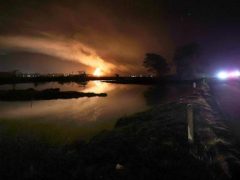AUSTIN, Texas — A fire at one of the world’s largest battery plants in Northern California contained tens of thousands of lithium batteries that store power from renewable energy and have become a growing electricity source.
By a long shot, California and Texas are opening more large-scale battery projects than anywhere else in the U.S., bolstering power reliability in two large states where extreme weather fueled by climate change has led to electricity shortages and blackouts.
The fire that started Thursday at the Vistra Energy battery plant in Moss Landing, roughly 80 miles (about 130 kilometers) south of San Francisco, led to 1,700 people evacuating, closed part of Highway 1 and generated huge flames and significant amounts of smoke. The cause is under investigation.
Experts say lithium batteries are a safe technology essential for lowering carbon emissions and making grids more reliable. Still, residents near the fire expressed concerns about the impact.
In Texas, which is bracing for another blast of Artic winter weather next week, officials have credited batteries with helping stabilize the state’s independent grid, which was pushed to the brink of collapse during a deadly winter storm in 2021.
Here’s how and why batteries are booming in the two states:
Both Texas and California grapple with blackouts while trying to meet the energy needs of tens of millions of people as well as industry, including artificial intelligence and data centers.
Batteries soak up excess wind and solar energy for later use. That backup supply helps the grid during times of high demand, such as during a heat wave, when air conditioning use is heavy.
The cost of lithium batteries has dropped dramatically, boosting their popularity. For electric vehicle lithium batteries, as an example, prices fell by about 90% between 2008 to 2022, according to the U.S. Department of Energy’s Vehicle Technologies Office.
Cheaper lithium has made utility-scale batteries more cost-competitive than some natural gas alternatives. Batteries can also be switched on and discharge power in a matter of seconds.
The Texas grid is rapidly gaining utility-scale batteries and added a whopping 5 gigawatts of storage over the last year, helping to keep up with demand and avoid blackouts.
The 2021 blackout and the Inflation Reduction Act of 20





